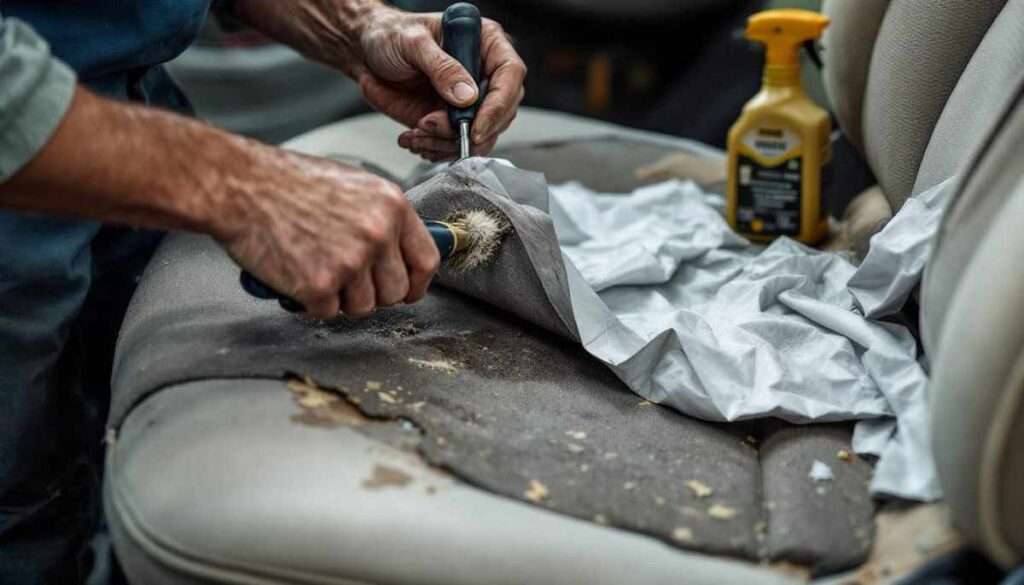
Upholstery material options for a 2000 Volvo V70
Replacing the upholstery on the rear seat of a 2000 Volvo V70 can breathe new life into your vehicle’s interior. Whether your upholstery is worn, stained, or outdated, a fresh look can greatly enhance your driving experience. This guide will walk you through each step of the process, ensuring you have a clear understanding of how to achieve the best results.
Understanding the Basics of Upholstery Replacement
Upholstery replacement is a task that requires some knowledge of materials and techniques. By understanding the basics, you set yourself up for a successful project. It’s not just about aesthetics; it’s also about maintaining the integrity of your vehicle’s interior. Choosing the right fabric and filling materials can significantly impact both comfort and durability, making it essential to consider your options carefully before diving into the project.
Importance of Upholstery Maintenance
Regular maintenance of upholstery can extend its life and keep your vehicle looking fresh. Dirt, spills, and wear can accumulate over time, leading to premature deterioration. By cleaning your upholstery regularly and addressing wear when it occurs, you can save money and effort in the long run. Utilizing appropriate cleaning products that are safe for your specific upholstery type is crucial, as harsh chemicals can cause further damage. Additionally, applying protective sprays can help resist stains and fading from UV exposure, ensuring your investment lasts longer.
Identifying the Need for Upholstery Replacement
Before starting the replacement process, it’s crucial to assess the condition of your upholstery. Look for signs such as tears, fading, or significant stains that cannot be cleaned. If the damage is extensive, replacing the upholstery may be the best solution. It’s also important to consider the age of the upholstery; older materials may not only look worn but could also harbor allergens or odors that are difficult to eliminate. In some cases, the underlying structure, such as foam padding or springs, may also require attention, as these components play a vital role in the overall comfort and support of your seating. Taking the time to evaluate all aspects of your upholstery will help ensure that your replacement project is both effective and satisfying.
Gathering the Necessary Tools and Materials
Once you’ve identified the need for replacement, the next step is gathering the appropriate tools and materials. Having everything prepared ahead of time will save you from unnecessary interruptions during the project. A well-organized workspace can significantly enhance your efficiency, allowing you to focus on the task at hand without the distraction of searching for misplaced items.
List of Tools Needed for Upholstery Replacement
- Screwdriver set
- Utility knife
- Stapler or upholstery stapler
- Measuring tape
- Fabric scissors
- Adhesive spray
- Sewing machine (optional for custom jobs)
These tools will allow you to remove the old upholstery, measure and cut the new material, and securely attach it to the seat frame. Additionally, having a good pair of gloves can protect your hands from sharp edges and prevent any injuries while working. A staple remover can also be a handy addition to your toolkit, making it easier to take off the old upholstery without damaging the underlying structure.
Choosing the Right Upholstery Material
Selecting the right fabric is critical for both aesthetics and longevity. Depending on your needs and budget, you can choose from various materials such as leather, vinyl, or fabric upholstery. Consider factors such as durability, ease of cleaning, and compatibility with your vehicle’s style. For instance, leather offers a luxurious look and is easy to wipe down, making it ideal for families with children or pets. On the other hand, high-quality fabric options can provide a comfortable feel and a wide range of colors and patterns to match your interior design.
Moreover, it’s essential to think about the weight and stretch of the material you choose. Heavier fabrics may require more effort to work with but can offer greater durability, while lighter materials might be easier to handle but could wear out more quickly. Always check the manufacturer’s recommendations and consider purchasing a sample to test how it looks and feels in your vehicle before making a final decision. This careful consideration will ensure that your upholstery not only looks great but also stands the test of time, enhancing your vehicle’s interior for years to come.
Preparing Your Work Area
A clean and organized workspace can significantly impact the success of your upholstery replacement project. Make sure you have adequate lighting and enough space to lay out the tools and materials. Natural light is ideal, so if possible, set up near a window. If you’re working in the evening or in a dimly lit area, consider investing in a good quality task lamp that provides bright, focused light to illuminate your work. This will help you see the finer details of your project and ensure precision in your work.
Additionally, consider the temperature and ventilation of your workspace. Upholstery projects can sometimes involve materials that emit fumes, especially when using adhesives or finishes. A well-ventilated area will not only keep you comfortable but also ensure that any harmful vapors dissipate quickly. If you’re working indoors, opening windows or using a fan can help maintain airflow. If you find yourself working in a confined space, consider wearing a respirator for added protection.
Safety Measures to Consider
Safety should always be a priority when undertaking a DIY project. Wear gloves to protect your hands from sharp tools and old upholstery materials, and consider wearing a mask if you are working with spray adhesives. Keep your workspace clear of unnecessary clutter to prevent accidents. It’s also wise to have a first aid kit on hand, just in case of minor injuries. Familiarize yourself with the location of the kit and ensure it is stocked with essentials like band-aids, antiseptic wipes, and gauze. Knowing that you have these supplies readily available can provide peace of mind as you work.
Moreover, be mindful of your posture and ergonomics while working. Using a sturdy chair or workbench at the right height can help prevent strain on your back and neck. If you’re cutting fabric or handling heavy materials, take breaks to stretch and move around. This will not only help you stay focused but also reduce the risk of repetitive strain injuries.
Organizing Your Tools and Materials
Before you start, organize your tools and materials in a way that makes them easy to access. Use containers or totes to keep everything in one place. Label each container, if necessary, to quickly find what you need without wasting time. Consider creating a checklist of all the tools and materials you require for the project, which can help ensure you don’t overlook anything important. This preparation can save you from unnecessary trips to the store mid-project.
In addition to organizing your tools, think about the layout of your workspace. Arrange your materials in a logical order based on the steps of your project. For instance, place your fabric and batting close to where you’ll be cutting and sewing, while keeping heavier tools like staple guns and hammers nearby for easy access. This thoughtful arrangement can streamline your workflow and enhance your overall efficiency, allowing you to focus more on the creative aspects of upholstery rather than searching for misplaced items.
Removing the Old Upholstery
Now that you’ve prepared your area and gathered your tools, it’s time to remove the old upholstery. This step involves careful handling to prevent damage to the underlying seat structure.
Steps to Safely Remove the Rear Seat
- Start by removing the rear seat from the vehicle. Look for bolts or clips that secure the seat in place and carefully unscrew or unclamp them.
- Once the seat is free, carry it to your workspace.
- Examine the underside of the seat to identify the fastening methods used for the upholstery.
Techniques for Removing Old Upholstery
Using your utility knife, carefully cut through the old stitching or staple points without damaging the foam padding underneath. Take your time during this process; rushing could lead to unnecessary damage. Once the fabric is removed, make sure to clean the seat frame thoroughly before laying down new material.
Installing the New Upholstery
Having removed the old upholstery, the next step is to install the new covering. This part of the project can be particularly rewarding, as you’ll see your efforts come to life.
Preparing the New Upholstery
Measure and cut the new upholstery material according to the dimensions of the old fabric, allowing for some extra material for tucking and stapling. It’s advisable to lay the new fabric out flat and ensure it’s wrinkle-free before proceeding.
Steps for Installing New Upholstery
- Start by positioning the new upholstery over the seat frame, ensuring it aligns with the edges.
- Begin stapling the fabric to the underside of the seat, starting from the center and working your way outwards to prevent bubbles or wrinkles.
- Once you’ve secured the upholstery, trim any excess material. Reattach the seat back into your vehicle, ensuring everything is tightened properly.
After completing these steps, take a moment to admire your work. Not only have you updated the aesthetics of your vehicle, but you’ve also likely enhanced its comfort. With proper care and regular maintenance, the newly upholstered seat will serve you well for years to come.





